How to Create Video-on-Demand Platforms that Help Your Business
The influence, use and growth of video-on-demand have been explosive. With billions of people hooked up to the internet, video streaming is booming. In light of this, many businesses are taking advantage.
Smart businesses in 2025-whether they be in technology, fitness, marketing or anything else-are monetizing their video-on-demand content. It makes complete sense, then, that many businesses are investing in video-on-demand content.
People are video streaming more than ever, with no signs of this trend slowing. According to Cisco’s Annual Internet Report, video is projected to account for 85% of all consumer internet traffic by 2025. Furthermore, in terms of global video streaming revenue growth, the global video streaming market is expected to grow from $699.91 billion in 2024 to $855.17 billion in 2025, representing a compound annual growth rate (CAGR) of 22.2%.
What is VOD exactly? Video-on-demand (VOD) lets viewers watch content anytime, anywhere, through subscriptions, rentals, or pay-per-view. Whether you want to add streaming to your site or build a full VOD website, you’ll need the right tools. Businesses use VOD for training, events, education, and entertainment. With demand at an all-time high, it’s a smart time to get started.
People choose video streaming through a video streaming website, platform, or video-on-demand website to grow their audience and revenue. With many VOD options available, learning how to create a video-on-demand website is key. This guide will help you build a VOD platform, set up your own video business, and choose the best tools for success.
Table of Contents
- What is a Video on Demand?
- The State of the Video-on-Demand Industry
- What Users Want from Video-on-Demand
- Where Video on Demand is Headed in 2025 and Beyond
- The Role of AI in VOD Platforms
- Benefits of Video-on-Demand for Your Business
- 9 Key Features of an Online Video Platform to Build a Video-on-Demand (VOD) Website for Business
- How to Create a Video-on-Demand Website in 9 Steps
- Comparison of Top VOD Platforms
- SEO and Accessibility Best Practices
- Key Features and Trends for Building a Future-Ready Video-on-Demand Platform
- Dacast – A Leading Online Video Platform for Building VOD Websites
- Conclusion
What is a Video on Demand?
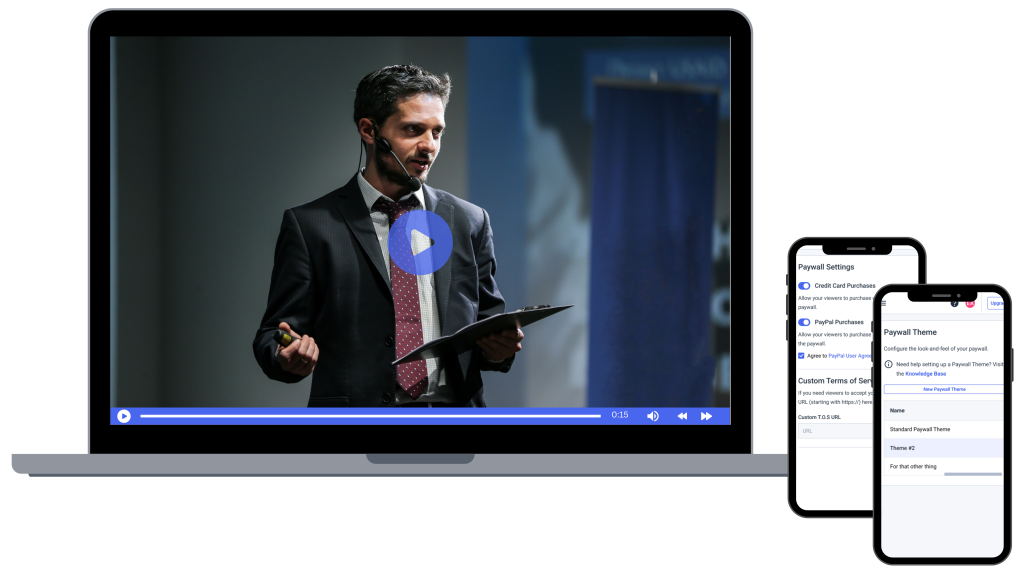
Video-on-demand refers to a distribution platform or service that delivers video content. This is done through subscriptions, pay-per-view and rentals. Today, this method of enjoying people’s favorite video-streaming content is ubiquitous. It allows users to watch videos when they want, wherever they are. It’s as simple as clicking a button or a link.
You may want to incorporate video streaming onto your current website. Or perhaps you want to share your own video by building a complete video-on-demand website. Whatever it is, you’ll need the right tools and features from a professional video streaming platform. Further, you want a video monetization platform that suits your needs.
For businesses, the most common uses for online video are:
- Interla training, updates and announcements.
- Training and educational content.
- Conferences and events.
- Entertainment.
In all these scenarios, video-on-demand is perfect. With the popularity of VOD at an all-time high, now is the perfect time to take advantage. With a VOD platform, your VOD streaming success takes a leap.
The State of the Video-on-Demand Industry
Much has been written about the effects of video-on-demand in the entertainment industry. According to Conviva’s State of Streaming Report, in the first quarter of 2022, people’s usage of streaming services like Netflix, Hulu, and Disney+ increased by 10% compared to the previous year.
Streaming is officially starting to surpass television in popularity as Nielsen research shows, in 2022, watching video streaming accounted for one-third of all TV time.
And just like TV, streaming isn’t just limited to entertainment. Education, fitness, and how-to content are all popular genres people are willing to spend money on. These niche markets are worth hundreds of millions and growing yearly.
The report explains that viewers are now watching more hours of content per day than they did a year ago, with live and on-demand content both increasing.
That means that the video-on-demand industry is growing, and people are increasingly interested in watching videos on their own time. They’re willing to pay for this privilege, too.
What Users Want from Video-on-Demand
With the increased demand for video streaming services, it’s important to understand what users look for when using video-on-demand platforms. User demand for on-demand video content is continuously growing as users want more personalization, accessibility, and portability in the content they consume.
Unsurprisingly, the price plays a major role when you select a video-on-demand streaming service. According to a 2022 Nielsen report, nearly 85% of all users rank cost as “extremely” or “very important” when picking a streaming service.
As the report details, other important factors include:
- 81% ease of use – how quickly can I find and watch the content I want?
- 79% content variety – does the service have a wide range of content I’m interested in?
- 77% streaming quality – is the video free of buffering or other technical issues?
- 74% menu selection – is the interface easy to navigate and understand?
As you can see, while the price is important, there are other things users want. To create a successful video-on-demand platform, you’ll need to focus on offering a great user experience.
That means having a platform with an intuitive interface, high-quality video-on-demand streaming, and a wide range of content is critical to success. So whether you’re a part of the entertainment industry or own a business and want to create an internal video-on-demand website, it’s important to understand what users are looking for.
Where Video on Demand is Headed in 2025 and Beyond
The video on demand landscape is quickly evolving in 2025. AI is being used to personalize viewer experiences, suggest content, and streamline video CMS for business. Edge delivery networks are making playback faster and more reliable across the globe. Ad-based video monetization is expanding as AVOD and FAST channels gain ground with advertisers and audiences alike. These trends offer new opportunities for anyone looking to start their own VOD streaming platform or build a video on demand website.
Platforms like Dacast are leading the way with white label video hosting, robust video API and SDKs, and flexible video monetization tools. Whether you want to create a VOD website for subscriptions, ads, or rentals, the right platform can make it easy to launch and grow. As the demand grows for custom video on demand platforms, using modern VOD platform development services will be key for long-term success.
The Role of AI in VOD Platforms
Smart content recommendations
AI helps platforms suggest the right videos to the right viewers based on past behavior, preferences, and trends. This makes it easier for your audience to find content they care about, which increases watch time and boosts engagement. When you build a VOD website, smart recommendations can set your platform apart from others.
Automated captioning/subtitling
Adding captions and subtitles used to be time-consuming, but AI tools now handle this automatically. This improves accessibility and helps you reach a wider audience. When you create a VOD website or use VOD platform development services, automated captioning can save time and reduce costs.
AI-powered video compression
AI improves video compression, keeping quality high while using less bandwidth. This makes secure video streaming faster and more reliable, especially for mobile users. It’s a must-have when you develop a video-on-demand site or OTT video platform.
Personalized content delivery
AI can help deliver custom experiences for each viewer, by region, device, or user history. This is essential when you want to start your own VOD streaming platform that feels personal and keeps viewers coming back.
Use of VOD in Business in 2025
Video-on-demand is no longer just for entertainment. In 2025, VOD is a key tool for businesses looking to scale communication, training, and engagement.
Take business conferences, for example. While in-person events still matter, many organizations now live stream keynotes and build video-on-demand websites to offer recorded sessions. This expands access to global audiences and increases ROI for organizers.
Beyond events, companies use VOD platforms for employee onboarding, compliance training, product demos, and internal updates. A custom VOD platform lets teams access content anytime, reducing costs and improving efficiency.
Whether you’re learning how to create a video-on-demand website or planning to start your own VOD streaming platform, the right video monetization platform—like the Dacast VOD platform—can help you deliver content professionally. In today’s hybrid business landscape, on-demand video is a must-have for growth.
Business Use Cases
Corporate: Internal training and executive communications
Video-on-demand is no longer just for entertainment. Businesses across every sector are turning to enterprise video on demand to boost efficiency, improve communication, and reduce costs. One major use case is internal training. Instead of flying employees to a central location, companies now build a custom VOD platform to host training materials that can be accessed anytime.
Executive teams are also using VOD platforms to share updates across large organizations. A recorded company-wide address or strategy session can be delivered via a secure video-on-demand website, ensuring that every team member, regardless of time zone, gets the same message. This is a smarter, scalable way to align global teams.
Here’s a real-world example: A global logistics firm built a secure video platform to deliver leadership updates and training to over 10,000 employees across five continents—helping unify its workforce during a major reorganization.
Media and Entertainment: Monetized content libraries
Media companies are leading the way in monetizing video content, but smaller studios and independent creators are catching up fast. With the rise of white-label video monetization platforms, it’s easier than ever to start your own VOD streaming platform, manage content rights, and generate revenue.
Content creators and media brands now use white-label VOD platforms to launch their own channels. Monetization options like pay-per-view and subscriptions help turn back catalogs into revenue.
For example, an independent film studio launched a branded video platform to release indie films directly to fans. Using the Dacast VOD platform, they saw a 40% increase in monthly revenue compared to third-party hosting sites.
Whether you’re repurposing past live events or distributing original series, building a VOD platform can open up new income streams through pay-per-view, ad-based, or subscription models.
Fitness and Wellness: Subscription-based workouts
Fitness and wellness brands have been quick to adopt on-demand video. From yoga instructors to personal trainers and mental wellness coaches, creating a subscription video website allows professionals to scale their businesses.
Fitness pros now use video-on-demand to scale their businesses. A subscription video website lets users access classes anytime, from yoga to strength training.
One personal trainer created a custom VOD platform to offer daily HIIT classes. Within six months, she replaced her in-person income with recurring revenue from over 700 paying members worldwide.
Rather than relying on in-person sessions or social media platforms, launching a branded, white-label VOD platform helps build customer loyalty and generate recurring revenue.
Education: On-demand learning portals
Educational institutions and professional trainers are investing in on-demand learning experiences. Whether for continuing education, certifications, or university courses, VOD development enables 24/7 learning.
On-demand learning is transforming education. Schools, coaches, and trainers use video platforms to deliver lessons that students can watch anytime, from any device.
A professional certification provider launched a VOD website offering prep courses and practice videos. Enrollment tripled after switching from live webinars to on-demand access via Dacast.
You can develop a video-on-demand site that supports course modules, quizzes, and certification paths. A reliable VOD platform provider can help you build a video streaming platform that’s secure, scalable, and accessible across devices.
Benefits of Video-on-Demand for Your Business
Launching a video-on-demand website may seem like a risk, but the right VOD platform can deliver measurable business results. Here are four key ways to track real value:
1. Increase Engagement and Brand Trust
A custom VOD platform helps you establish authority in your industry. Hosting webinars, tutorials, and company stories directly on your site boosts engagement time and positions you as a trusted expert. High-quality videos increase credibility and keep visitors on your platform longer—an essential KPI for content performance.
2. Educate to Drive Conversions
Over half of consumers use video to learn new skills. A dedicated VOD platform lets you deliver product demos, how-tos, and educational content without sending viewers off-site. This supports lead generation, builds confidence, and moves potential customers closer to a purchase.
3. Humanize Your Brand
Consumers connect with people, not logos. A VOD platform is a powerful way to share your brand story, team culture, or behind-the-scenes content. This kind of video builds loyalty and drives return visits. Platforms like the Dacast VOD platform make publishing easy and secure.
4. Unlock New Revenue Streams
The best VOD platforms for business offer monetization tools such as subscriptions, rentals, and pay-per-view. You can also gate premium content to capture leads or sell access to training programs and courses. These tools turn video into a scalable source of income and growth.
Ready to build your VOD website? Start exploring the top video-on-demand platform providers and find the right solution to grow your brand and revenue.
9 Key Features of an Online Video Platform to Build a Video-on-Demand (VOD) Website for Business
There are many video-on-demand platforms on the market. However, they each have different sets of tools at different price points.
Here are nine important features to look for when choosing an online video platform for building a VOD website.
1. White-Label Video Player
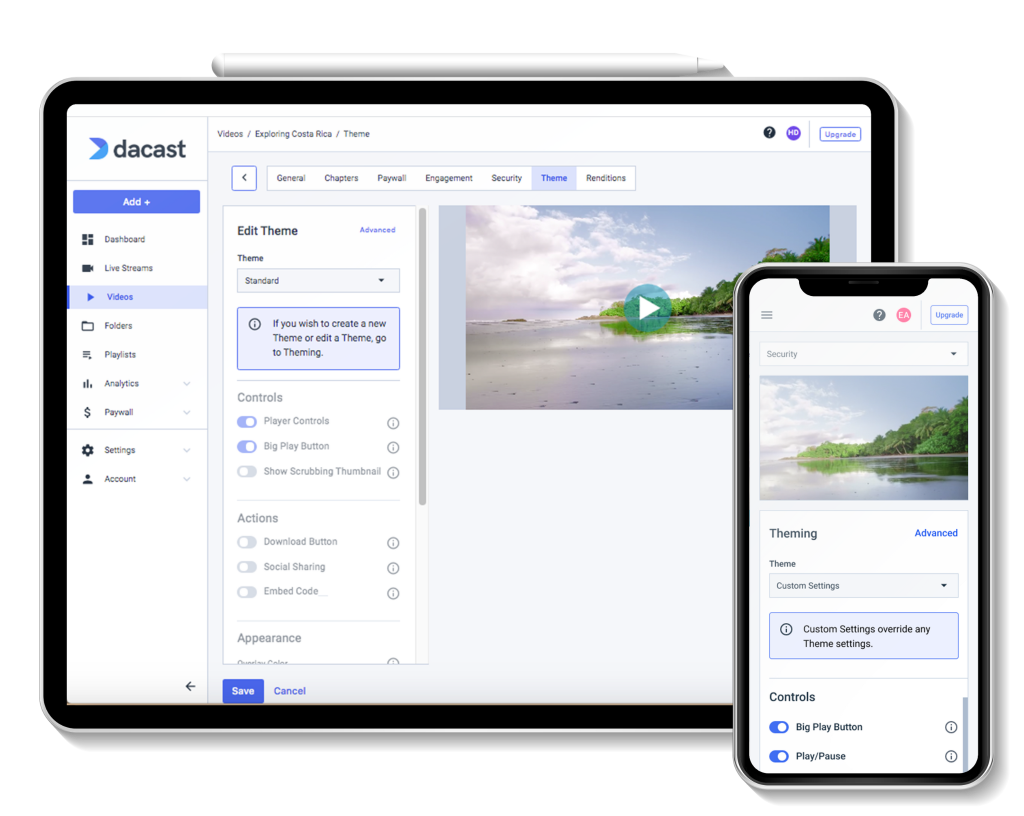
A white-label service is one of the most important features for creating a video-on-demand website. Simply put, a white-label video player does not include any third-party branding. The only logos and branding on white-label video content are whatever you choose to include.
An all-device HTML5 video player typically has white-label capabilities and provides an on-brand appearance.
That is a much more professional approach compared to a consumer-grade video hosting platform, like YouTube, that has ads and YouTube’s branding.
Consumer-grade video-on-demand platforms are free because they run advertisements and brand each video with their logo. In contrast, a white-label service ensures that your brand is front and center.
2. Simple Embed Process
Embedding a video on your website is a key part of building a video-on-demand solution. Some video-on-demand platforms make this easy, while others have more complex embedding processes.
Embedding videos should be as simple as copying an embed code from your video host and pasting it into your website’s backend. The process works with all major CMS providers, such as WordPress, Squarespace, and beyond.
Embedding your video to social media platforms is a possibility, as well. You can also simulcast your videos, streaming to multiple platforms simultaneously.
3. API and SDKs for Easy Development
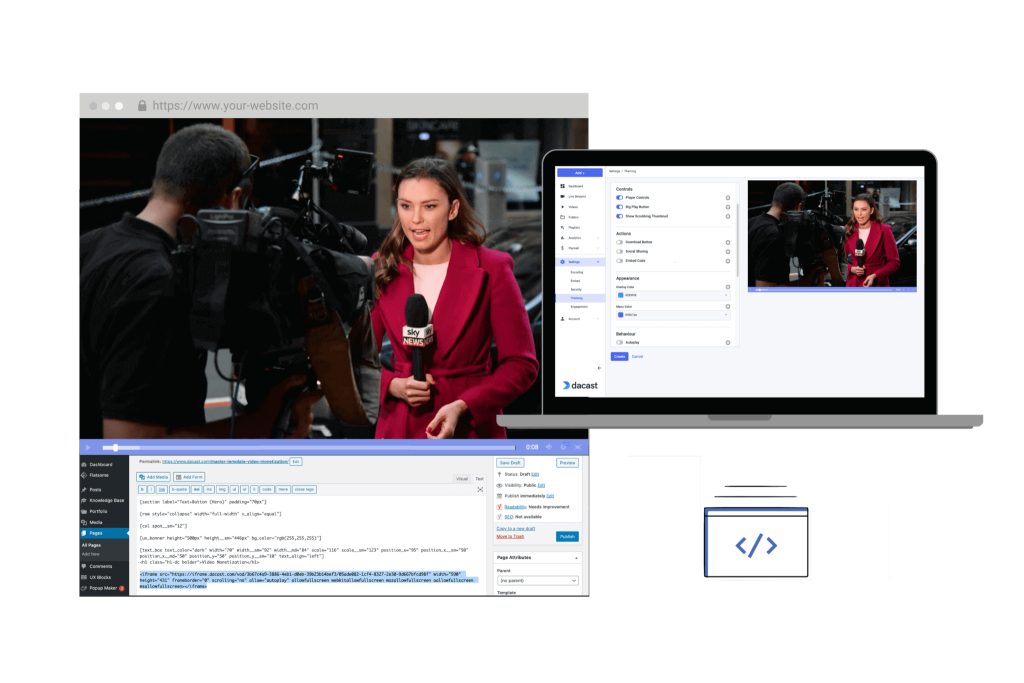
As of 2020, most businesses are migrating to API-based workflows for online video. Video APIs, or Application Programming Interfaces, enable custom development and integration.
With video API, you can customize the video hosting experience. Another type of API, player API, gives you the power to customize your video player further.
APIs are essential in the modern workflow for video projects that are more complex than simple uploading and embedding.
Streaming Media states, “ The video workflow and distribution environments are incredibly complex. The way to build a best-of-breed system or even gain finer control over tasks—especially when delivering video at scale—is by API.“
Software Development Kits (SDK) are similarly important. These simplify the process of developing mobile apps and services for different platforms.
Building a mobile app opens the potential to grow your subscriber base substantially. Therefore, video-on-demand platforms for businesses should ideally include both APIs and mobile player SDKs to make their custom development easier.
4. Cloud Video Transcoding Services
Most modern video cameras record in different sizes and formats. Additionally, those who view your videos must also watch in different sizes due to varying internet speeds and device capabilities.
Some of your viewers are likely using cell phones with slow internet connections, while others are on fast connections and large, high-resolution screens.
Meeting the needs of consumers and standardizing viewing formats presents some technical challenges. Cloud video transcoding solves this problem by creating multiple “ renditions” at different bitrates for viewers with different internet speeds.
Combined with an adaptive video player, it’ll allow you to automatically upload any video, click one button to transcode to multiple renditions, and serve it to your viewers in the appropriate adaptive bitrate.
5. Video CMS
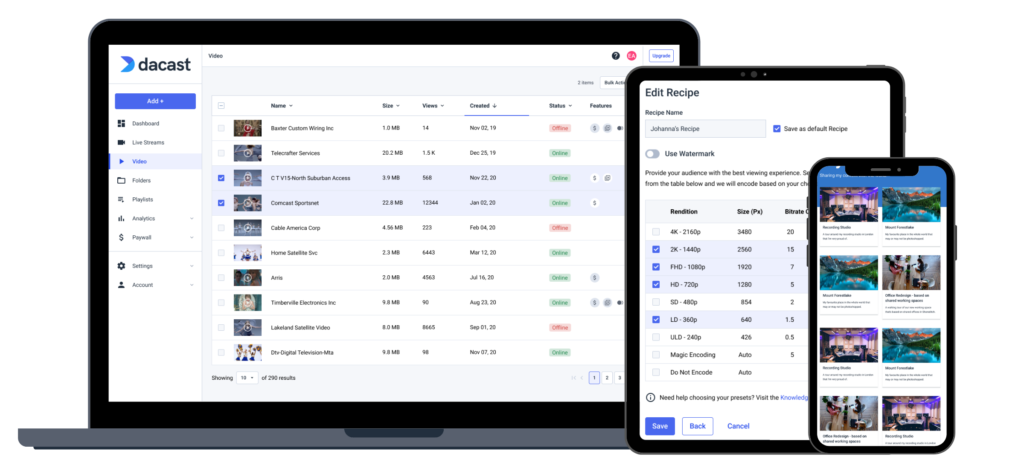
A broadcaster needs a centralized interface to host and manage content. The best tool for organizing and managing your content is a video content management system (CMS).
Your video CMS will allow you to sort videos into categories, tags, or folders. It also makes your content searchable, making it easy to perform bulk actions on multiple videos.
It’s particularly valuable if your video-on-demand platform allows you to provision multiple users/admins with different permissions for managing, uploading, and publishing content to your account.
6. Privacy and Security Features
In this age of cyber attacks and the popularity of the dark web, you can’t compromise user privacy and website security.
Since you’ll most likely ask users to create an account with you and share personal details, including a credit card, you must ensure their privacy.
For that, look for an online video platform with password protection and Advanced Encryption Standard ( AES) encryption.
These websites are a target for phishing scams, especially if you have ads on your website. Advanced security keeps you and your users safe as it protects your video-on-demand platform from being hacked and the content from being stolen.
But be careful of subpar security features. That’s because the last thing you want is to block an authorized user out. After all, they changed their location or used an unsafe device to log in.
7. Range of Additional Features
Some video-on-demand platforms have features that are nonessential for others. Your VOD platform will probably need some unique features. Some of these include
- Options for content segregation, such as behind a paywall or for users with subscription plans
- Accessibility features, such as subtitles, audio descriptions, and transcripts
- Number of supported languages
- Social media integration
- SEO tools
- Unlimited storage
- Option to geo-block content
- Restrict download of certain videos
- Instant playback
Make sure you identify which of these you’ll need based on your business, and audience and then choose an appropriate platform to create your VOD website.
8. Video Analytics
Data about how your videos perform helps you improve content quality, identify the most watched content, troubleshoot problems with streaming, and enhance user experience, to name only a few benefits.
If you’re competing for viewers, having good analytics features becomes essential to optimize your content efficiently.
And you can only rely on something other than Google Analytics because it sometimes offers you video-specific data, such as watch time and estimated revenue.
You also must be extremely cautious about following privacy regulations when tracking users’ data. That’s why, in addition to checking for excellent video analytics features, check whether the online video platform’s analytics tool is GDPR compliant. They should also preferably have security certificates such as ISO/IEC 27001.
9. Multiple Options for Monetizing Your Content
If you’re creating a video-on-demand website for extra revenue, you should choose an online video platform that offers you a range of monetization options. Some common ones include subscription-based monetization, transactional, ad-based, and pay-per-view streaming (more on that later).
You should check the percentage of the online video platform’s cut to determine if you’re getting a good deal. Also, look into how convenient the setup is and which payment methods they support.
How to Create a Video-on-Demand Website in 9 Steps
Now that you’re familiar with nine of the top features for creating a VOD website, let’s discuss how to create one for your business or organization with the support of an online video platform.
1. Identify Your Audience
Wait to start working on creating the content until you identify who you’re targeting.
You need to have one or a couple of user personas ready. Feel free to use the ones you already have for your business or create new ones, especially if you want to increase your audience.
Use the data points you already have and get professional marketers on board. Nothing beats highly personalized content and experience. It’s wise to take your time during this stage and be as clear as possible about who your audience is.
2. Plan and Strategize
Before you build a VOD website, you must develop a solid strategy. First, identify what you’re trying to achieve.
And then, plan out your content with your target audience in mind. Map out your video series, write scripts, and determine your needed equipment. It would be best if you had a decent idea of what you will do before you start.
At this stage, you should also work out who you’ll need to hire for filming, acting, editing, directing, and web development.
3. Produce Your Content
Once you’ve planned everything, it’s time to produce the content for your VOD website. Depending on your goals, you may want to release many videos simultaneously, so this step could take several weeks or months.
You may plan a full-scale theatrical production with a cast of actors, a complicated set and costume design, and multiple camera angles. Or, you might plan a simple information series where one person casually talks to a camera.
Generally, content production starts with scriptwriting. You might have professionals from your brand or organization “star” in your content, or you could hire paid actors. The way you approach this will depend on the type of content you create.
Some companies start generating content by recording virtual events and live streams. Uploading previously live content as a VOD file is a great way to repurpose your content.
4. Develop Your Website
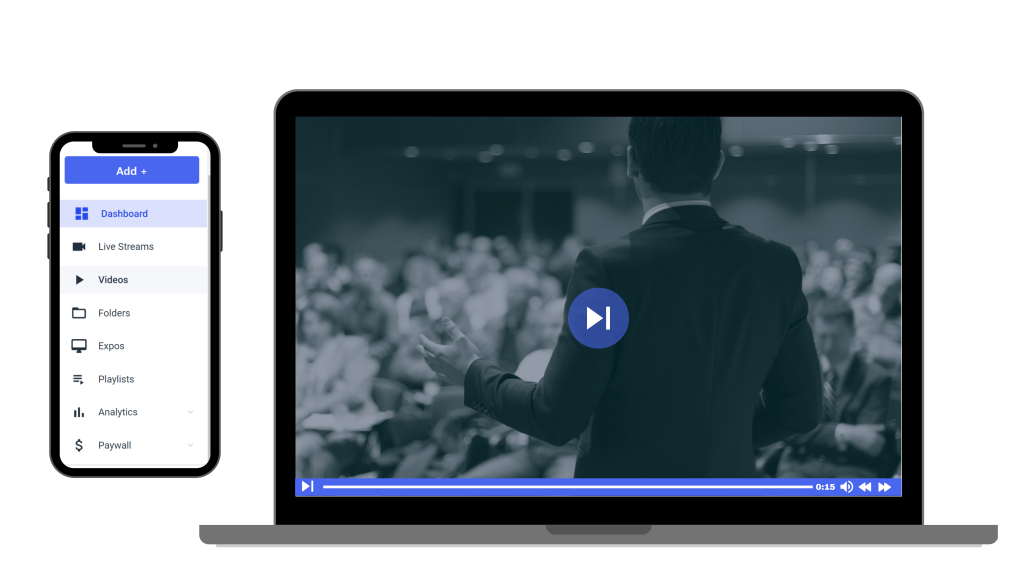
Your VOD content needs a place to live, so you’ll need to develop a website. To create your video-on-demand website, you must consider several things, such as video content, management, and monetization strategies.
You can either build a section on your existing business website or an entirely new one. Building a new website is a good idea to keep things better organized. That could also elevate the viewers’ experience.
If you decide to build a new website, you can hire a development team or leave the responsibility to a skilled and experienced team member.
Pro tip: You’ll want your site to be professional, on-brand, and easy to navigate. It’s generally a good idea to have an experienced developer build your site rather than take a DIY approach to ensure the best results.
5. Understand the Difference Between Streaming vs. VOD vs. OTT
Before uploading content, it’s important to understand the different types of streaming.
Live streaming delivers content in real-time, while video-on-demand (VOD) features pre-recorded content stored on a server. Cable-supported VOD allows users to stream content like sports and movies via a set-top box, with pause, rewind, and fast-forward options. OTT (over-the-top) streaming, often subscription-based or pay-per-view, delivers on-demand content over the internet, like the model many businesses adopt when creating a video-on-demand website.
6. Upload Your Content
Once your content is ready, you’ll want to upload it to your video hosting platform. Make sure you’ve chosen an online video platform that offers secure upload.
If you’re uploading batches of large video files at once, you’ll want to check if your OVP offers FTP upload.
Many OVPs allow users to upload content to playlists to create series. That’s great for streaming different series of content and keeping it well-organized.
7. Embed Your Video Player
After you’ve uploaded your content to your OVP, it’s time to embed your video player on the website you developed in step 3.
Most video-on-demand platforms allow broadcasters to manually embed a video player in a website using embed codes. Two embed codes are available: JS (Javascript) and iframe.
JS embed code is more universally compatible with the full-screen feature. The JS embed code is also a requirement for the URL referral restriction feature to work. The iframe embed code is more compatible with some website hosts, including WordPress and Wix.
Copy your chosen embed code and insert it into your website. Find the place on your site where you’d like to embed the video player. Next, open the HTML editor, and paste the embed code you copied from your OVP.
Preview the changes to make sure the code is working properly.
Using domain restriction or signed embed codes, you can also share videos privately to ensure that your videos are only accessible on websites you own.
Test your embedded video players on your new VOD platform to ensure everything is ready to go when your viewers access the content.
8. Promote Your VOD Website
If everything runs smoothly during your test runs, it is time to promote your VOD website. Your promotion methods will depend on the purpose of your content.
For internal content, your “promotion” will be sharing the link to your website with the members of your team who need to see it.
However, if you’re monetizing your on-demand website and making it a VOD streaming service, you’ll want to put more time and energy into marketing and advertising your site.
9. Monetize Your Content
Begin by identifying the monetization model you want to use. Remember, you can always choose more than one for different content categories.
Here’s a quick overview of your options:
- Subscription-based VOD: The model that Netflix and Hulu follow. Your users will pay monthly or yearly and get access to all the content available in their region, but only for the subscription duration.
- Advertisement-based VOD: Here, your content is free for streaming, and you earn through ads that are played before and during the video. Facebook Watch uses this method to generate revenue.
- Transactional VOD: In this option, you charge users just one, for a specific piece or series of content. It’s similar to buying or renting a DVD from a store. Udemy follows this monetization strategy.
- Hybrid monetization (SVOD + AVOD): A hybrid monetization strategy that combines Subscription Video on Demand (SVOD) and Ad-Supported Video on Demand (AVOD) offers businesses flexibility. SVOD provides a steady income stream from paying subscribers, while AVOD allows free access supported by ads. This approach is ideal for industries like media and entertainment, where monetizing content libraries is key, or fitness/wellness, where subscription-based workouts can thrive with ad-supported free trials.
- Freemium to premium funnels: Freemium-to-premium funnels allow businesses to attract users with free content and convert them into paying subscribers by offering more premium features. This model works well in education, where users can access basic learning materials and upgrade for advanced courses. It’s also effective in media and entertainment for monetizing exclusive content.
- FAST (Free Ad-Supported Streaming TV) channels: FAST channels, which offer free, ad-supported content, have gained traction in industries like media and entertainment and even fitness/wellness. These channels are ideal for businesses that want to reach large audiences with minimal upfront costs while generating revenue through ads. Companies can tap into this model by building their own ad-supported video-on-demand platforms.
Comparison of Top VOD Platforms
Here is a handy comparison table of popular VOD platforms, showing how they stack up in key areas that matter most to businesses:
| Feature | Dacast | Vimeo OTT | Brightcove | Uscreen | JWPlayer |
| White-label support | Full white-label with branding control | Available, limited customization | Full white-label branding | Full white-label with templates | Available, less flexible |
| Monetization models | Subscriptions, pay-per-view, ads | Subscriptions | Subscriptions, ads | Subscriptions, rentals | Primarily ad-based |
| Security | DRM, password protection, domain restrictions, AES encryption | Basic security, limited DRM | Enterprise-grade DRM, SSO | SSL, geo-blocking, password | AES encryption, token signing |
| Live-to-VOD workflows | Seamless live-to-VOD conversion | Manual upload after live stream | Advanced live-to-VOD capabilities | Manual upload | Basic live-to-VOD support |
Dacast offers a strong all-in-one solution with flexible monetization, robust security, and easy live-to-VOD conversion, making it ideal for businesses looking to create a VOD website or build a custom video-on-demand platform. Competitors like Brightcove and Vimeo OTT are strong but may come at a higher price or offer less control, while Uscreen is great for creators but less enterprise-focused. JWPlayer suits ad-based models but lacks full-featured monetization and workflow options.
SEO and Accessibility Best Practices
To make your video-on-demand website more discoverable and user-friendly, follow SEO and accessibility best practices from the start. Use schema markup such as VideoObject and BroadcastService to help search engines better understand and display your content in rich results. This can improve visibility when people search for terms like “how to build a VOD platform” or “start my own VOD streaming platform.”
Accessibility is just as important. Make sure your platform supports keyboard navigation and works well with screen readers. This helps users with disabilities navigate your site and enjoy your content. Following WCAG 2.2 standards ensures your site is inclusive and legally compliant.
When you create a video-on-demand platform, keep SEO and accessibility in mind from the start. It not only improves the user experience but also strengthens your reach as you build your video on demand business.
Key Features and Trends for Building a Future-Ready Video-on-Demand Platform
Interactive Video Support
When considering how to create a video-on-demand website, interactive video features can significantly enhance user engagement. VOD tools that offer branching, quizzes, or real-time feedback provide a dynamic experience for viewers. For businesses or educational platforms, interactive videos can drive viewer participation and improve content retention. Many top video-on-demand platform providers, like Dacast, now support these features, allowing you to integrate interactive elements that turn passive viewing into an immersive experience. This makes your video platform not only more engaging but also effective in delivering key messages or educational content.
AI Content Tagging & Searchability
To build a VOD platform that stands out, especially for enterprise or educational content libraries, AI content tagging is essential. AI-driven tools can automatically tag videos with relevant keywords, making it easier for viewers to search and find specific content. This enhanced searchability ensures that your audience can access videos quickly, saving them time and improving their overall experience. A custom VOD platform with integrated AI features can significantly increase the value of your content library by improving organization and discoverability, which is crucial for large-scale platforms or subscription video websites.
Green Streaming Practices
As environmental awareness grows, 2025 trends show that more businesses are focusing on green streaming practices. Energy-efficient encoding and carbon-aware CDN usage are increasingly important to reduce your platform’s environmental impact. By choosing video-on-demand solutions that use these technologies, you can lower your carbon footprint while maintaining a high-quality streaming experience. Providers like Dacast are leading the charge in incorporating these eco-friendly practices, allowing businesses to align their video-on-demand services with sustainability goals. If you’re planning to start your own VOD streaming platform, integrating these green practices can be a key differentiator in the market.
Dacast-Specific Edge
Dacast offers a future-ready VOD platform solution that combines advanced features, such as AI, WebRTC, ultra-low latency, and multi-CDN support. These features ensure that your video-on-demand platform runs smoothly, providing viewers with a high-quality streaming experience regardless of their location. By choosing Dacast as your VOD platform provider, you gain access to tools that help you build a scalable, customizable VOD website. Whether you’re looking to monetize content, launch a subscription video website, or create a custom VOD platform, Dacast’s comprehensive solutions make it easier to build a video-on-demand business that’s ready for the future.
Dacast – A Leading Online Video Platform for Building VOD Websites
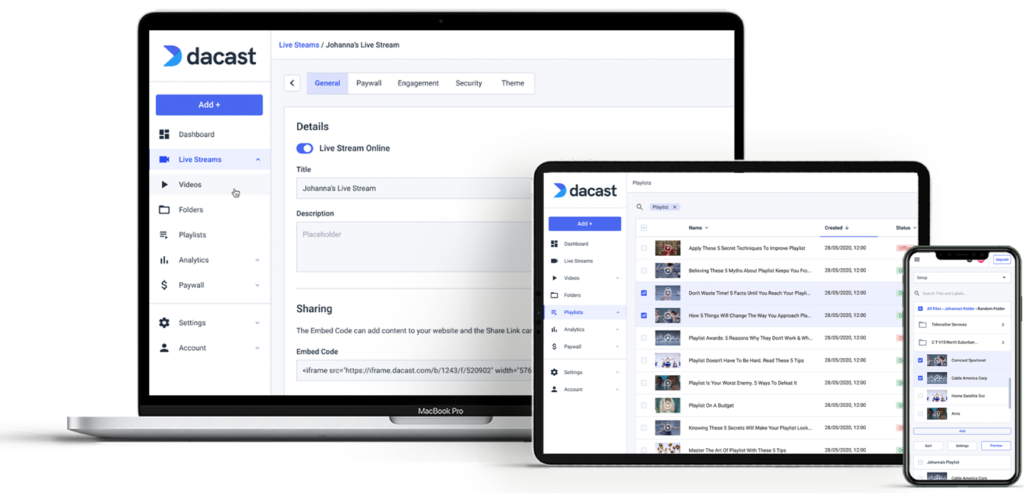
When building a VOD website, a feature-rich online video platform (OVP) will help streamline the process.
You now know what VOD is and how valuable it is. You also know how beneficial it can be for your business. Now you need a feature-rich online video platform (OVP) to set you up for VOD streaming success.
With the high demand and value of VOD streaming, you need a dedicated, professional service. Using a free streaming platform won’t suffice. The performance will likely be a bottleneck and you likely won’t receive important features such as video monetization.
You need a dedicated video streaming platform like Dacast. With Dacast, you can host and live-stream your own video and create your own VOD platform. Dacast also allows you to easily upload, transcode and organize all your video content. Further, Dacast makes it easy for content owners to analyze what’s performing well and what’s not. This allows businesses to continually tweak and improve their VOD content for maximum results.
Want to explore more options for online video platforms? Look at our online video platform comparison post to review the top options available.
Conclusion
Video streaming is a powerful tool for modern businesses. But, at the same time, knowing how and where to start can be intimidating. After all, video-on-demand platforms aren’t easy to operate without experience.
That’s why we’ve covered all the details that you should know about selecting a video-on-demand platform and building a VOD website for your business.
Dacast has been named the best SMB video platform for two years running. In addition to the features discussed in this article, Dacast includes various powerful tools for monetization, analytics, and more.
We also offer professional services to help you get your business VOD platform up and running. In addition, you can check out our live streaming pricing plans to learn more.
With that in mind, So, are you ready to give the Dacast streaming solutions a try? If so, click the link below to get free streaming for 14 days. You can be ready to stream live video in a matter of minutes. No credit card is required.
Finally, please contact us via the chat feature below if you have further questions or thoughts. Are you looking for more live streaming tips, industry networking opportunities, and exclusive offers? If so, you can also join our LinkedIn group.
Thanks for reading, and happy broadcasting!
 Stream
Stream Connect
Connect Manage
Manage Measure
Measure Events
Events Business
Business Organizations
Organizations Entertainment and Media
Entertainment and Media API
API Tools
Tools Learning Center
Learning Center Support
Support Support Articles
Support Articles